I like a nice Pogue. The trouble is, a lot of 6139-600x watches you’ll find on eBay are less than straight – a great many have been put together or at least tarted up with aftermarket parts, accompanied by a description that neatly avoids saying they’ve been prepared. Caveat emptor and all that.
I’m going to share some thoughts on what to look for in finding an authentic Pogue – over time, your eye will just know something doesn’t look right, but it’s useful to have a few rules in mind when assessing a potential watch for purchase.
Condition – is it consistent? Leave aside things like the crystal, which is a consumable, and ask – do the hands and dial match (age-wise; if the hands are bright and clean and the dial is marked and dirty, what does that tell you?). Remember, it doesn’t need to be immaculate … if you’re looking for authenticity, it may be that the flawed and worn, scratched and discoloured watch is the one that is genuine, whereas the shiny and polished one has been built up from a set of parts.
The distinctive “Pepsi” bezel on the 6139-600x Seiko Pogue is quite easy to replace – it pops off with a case knife and pressed on again using a crystal press, so any hamfisted tinkerer could change it. If you see a watch that looks really crisp and clean, and you can tell it’s got a fake/aftermarket bezel on it, then that maybe tells you all you need to know about the rest of the watch, and the seller who hasn’t pointed such a thing out.
The bezels appear to be pretty consistent throughout the watch’s shelf-life, except that some have a square block at the very top of the bezel. Most known aftermarket bezels don’t have a white box under the 60 at 12-o’clock – but since lots of genuine, especially early, watches don’t either (incl Pogues own), and aftermarkets are now showing up with a block, it’s no longer a reliable way to spot them without looking at other evidence.
Nick’s Pogue, previously discussed – it’s all original
Now, there are several tell-tales in checking if a bezel is real or reproduction:
-
- Aftermarket bezels tend to be flat, whereas lots of – but not necessarily all – genuine ones have a noticeable bevelled edge (as you can see in Nick’s example above, along the lower edge of the bezel).
- There was once a tell-tale about the shape of the 5s – real bezels have 5s that are nearly closed, whereas AM ones were noticeably more open. I don’t think this is reliable now.
- Some AM bezels don’t have a crisp division between red and blue between the 6 and 0 – it should be straight down the middle, though on a later genuine bezel with the block under 60, the start of the red can look closer to the 6.
- Some AM bezels have the 80, 85 and 90 very close to – even touching – the edge, but the latest seem to have fixed that, and on old genuine bezels, it can be hard to tell (look at Pogue’s again…)
- Pretty much visible to the naked eye – the stroke below the 2 of 250 on many aftermarket bezels reaches the end of the 2, whereas on genuine bezels, it doesn’t.
- The horizontal stroke in 4 in 140 on a genuine bezel should be nearly touching the zero, which means it can look longer than the 4 in 54. This still looks to be the case on the latest fakes, but it’s not jumping-out obvious. The marker at 140 though, on genuine bezels, finishes below the tip of the one and between the 1 and the 4, whereas on the fakes it’s often closer to the 4 and finishes above the 1.
- The TACHYMETER font is sometimes a bit variable too – on later AM bezels it’s quite close to the markers on the lower edge of the bezel and the lettering is quite square in shape, whereas on genuine bezels the letters are a little taller and there’s a bigger gap between the bottom of the letters and the markers, than there is between the top of the letters and the upper edge.
Some earlier fakes had even taller-looking lettering that was practically touching the upper edge of the bezel so again, there’s little consistency I think.
Let’s look at some examples – here’s an aftermarket bezel from eBay:
Note the markers under the 250 and above 140.
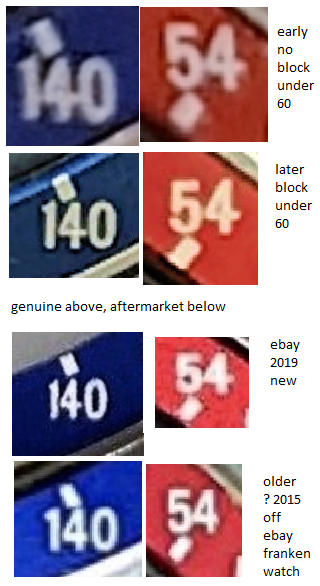 Now some comparisons – the upper two examples of the 54 and 140 are from good bezels of different ages, and the lower ones are known fakes.
Now some comparisons – the upper two examples of the 54 and 140 are from good bezels of different ages, and the lower ones are known fakes.
Look at the finish of the marker line above 140 – if you drew a line between the tops of the 1 and the 4, the marker would just dip inside it, more or less in the middle. On aftermarket bezels, it tends to finish higher up, and the lowest point of the marker isn’t in the middle of the 1 and 4.
Here’s the top and sides of a known, good 1970 bezel:
And another, this time with a block:
Compared to a known aftermarket from eBay, c2016:
and the same features from the 2019 eBay one already pictured:
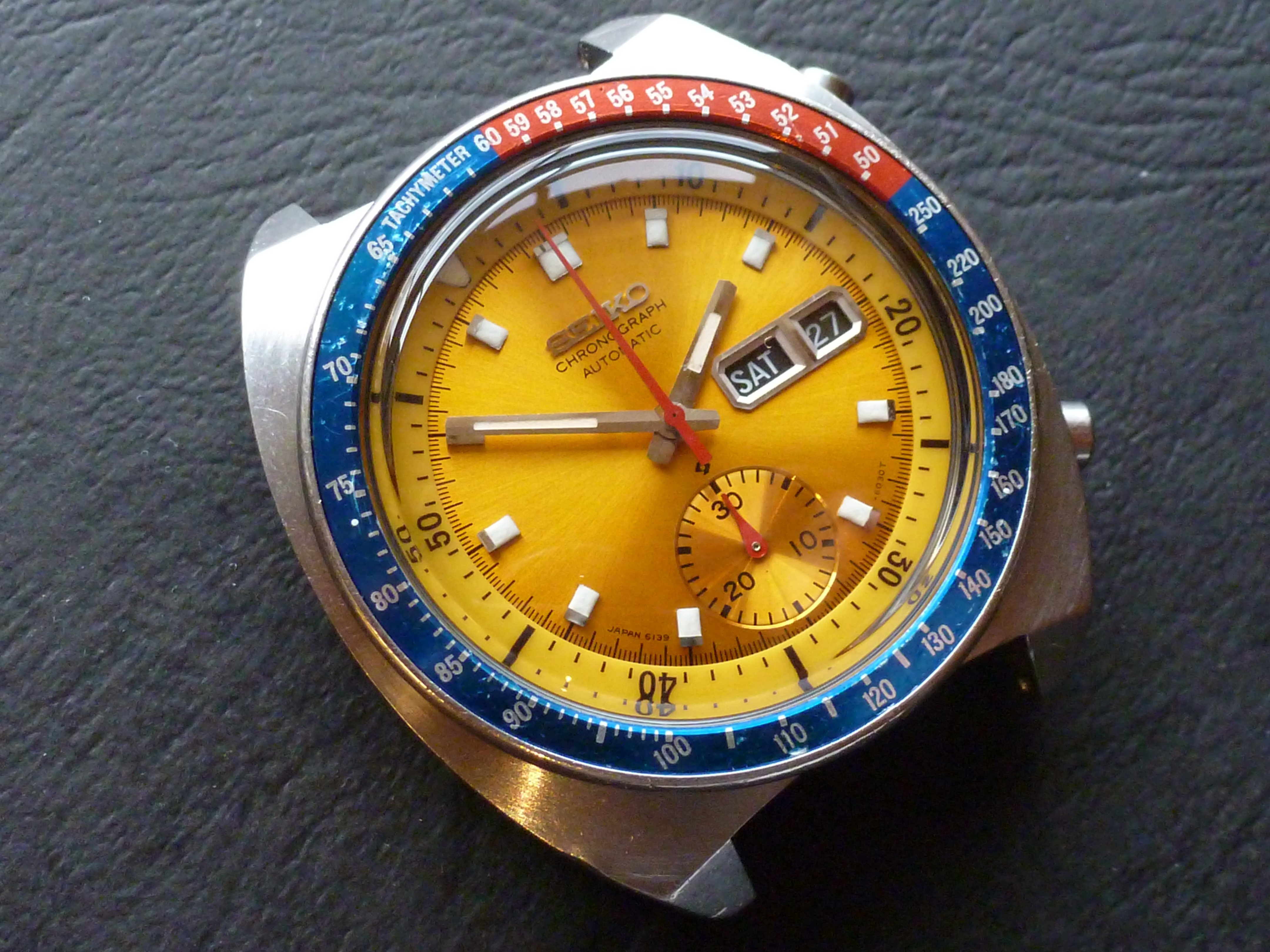
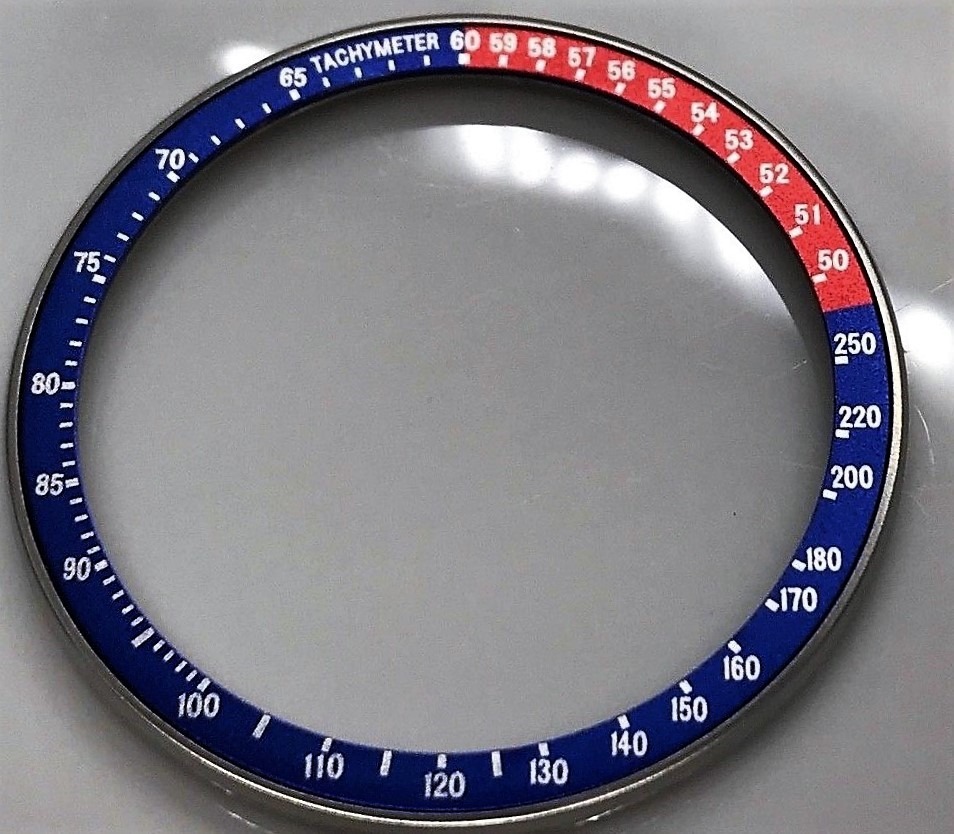
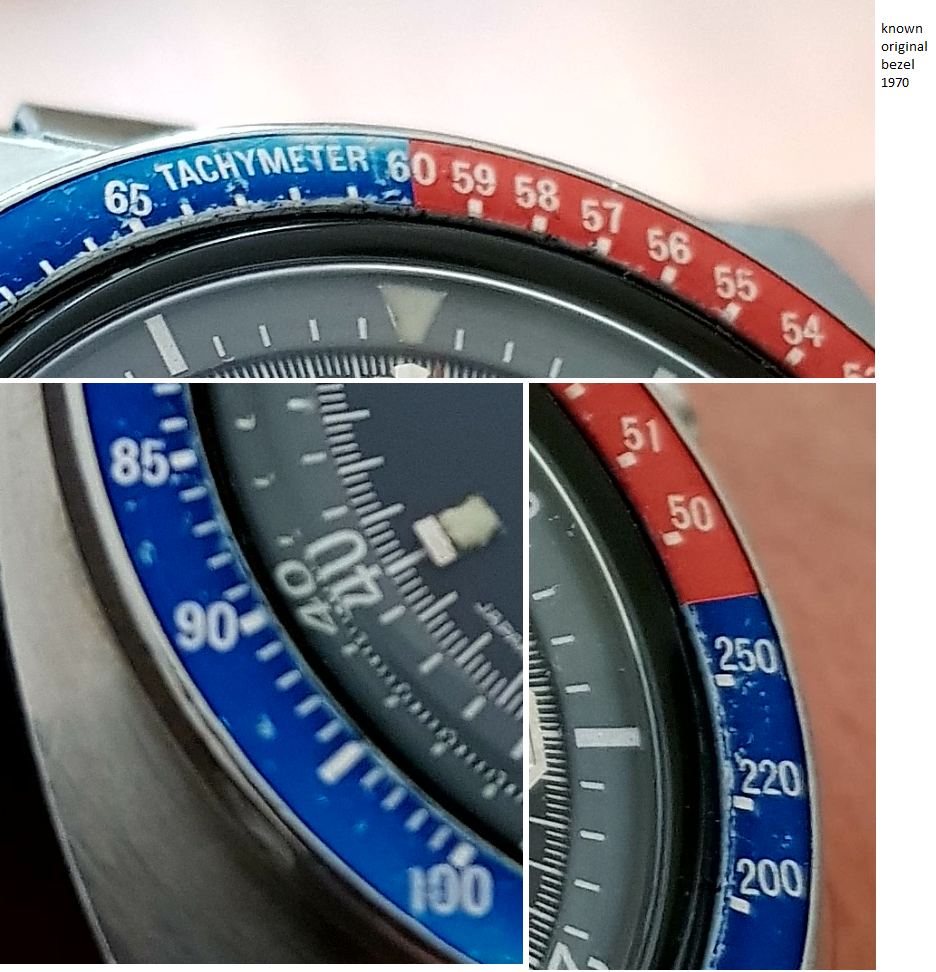
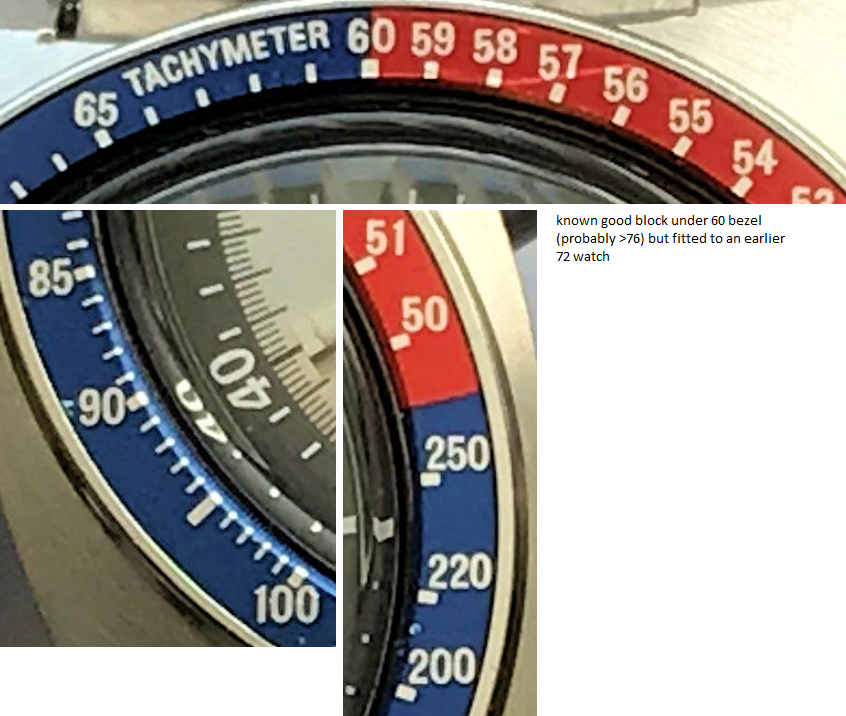
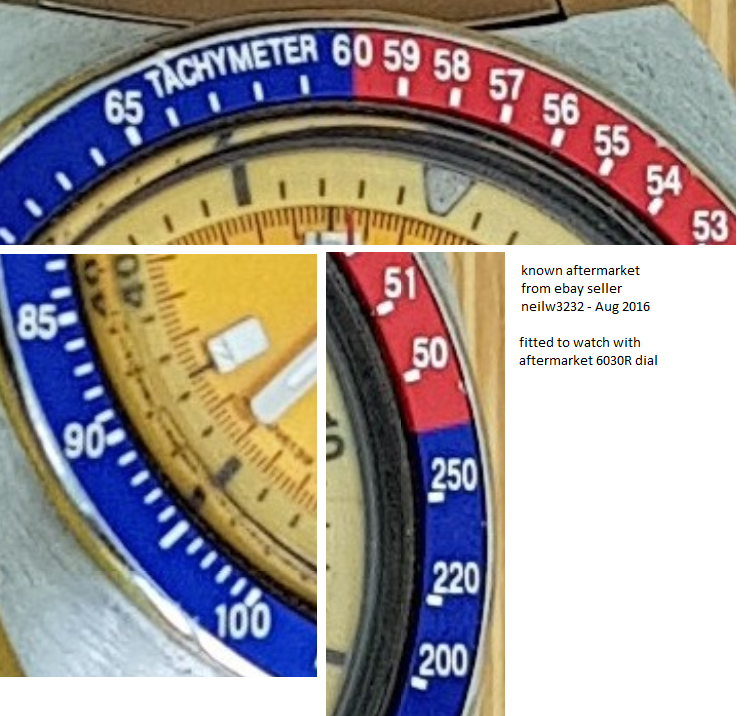
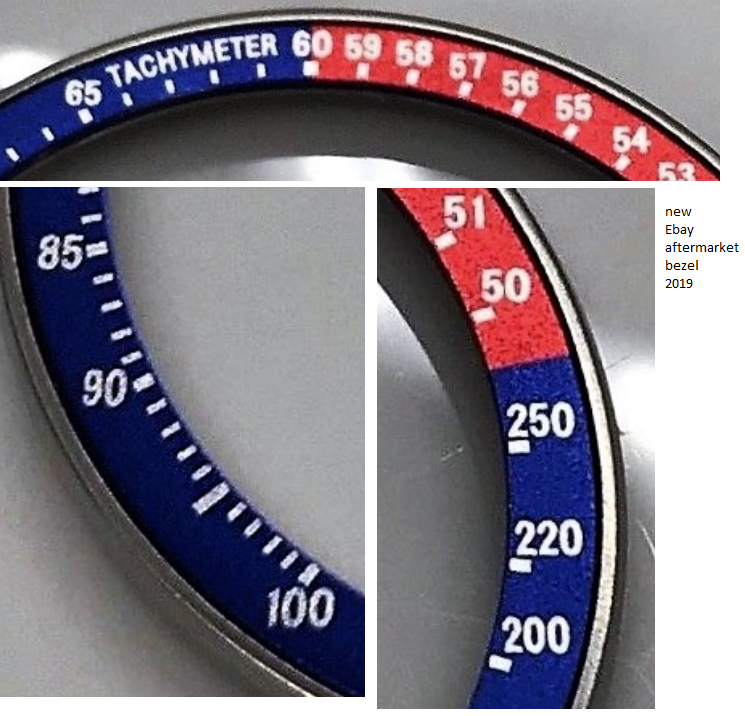
My dad has just given me one of these he bought in 1975. Problem is it has no bezel it fell off one day when he banged it on the car, And the bottom Chrono graph button is stuck in am I on a lost cause to get this fixed for him? It’s a beautiful watch with the Golden sunburst dial oh and it needs a new glass as he had it replaced and I don’t think it’s the right one. Thank you in advance Andy
hi Andy – there are various specialists around the world who can fix up with original parts (or worst case with replacement parts; the crystal is OK to replace IMHO, and there are aftermarket bezels out there which might look better than not having one… but it’s always better if you could find a real one). Check out WristSushi or SCWF (Google is your friend) for advice on the best watchmaker near to you.